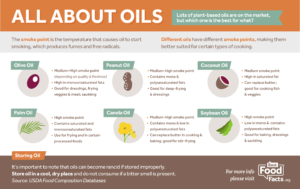
All About Cooking Oils
03/29/2019
Cooking oil is a staple in many of our cupboards and diets, and different oils can provide unique flavors, smells and textures to our favorite recipes. If you’re tired of your go-to oil and looking to try something new, grocery store shelves are filled with various kinds. From nut-based to classics, there are many options for experimenting with something new.
How do different oils factor into a healthy diet? It all comes down to the types of fat found in the oil. We asked Connie Diekman, Director of University Nutrition at Washington University in St. Louis, to give us an overview of the different types of fats and their impacts on health.
“Fat provides satiety (the feeling of being full) and enjoyment to the food we eat, but it also serves nutritional benefits. Fats are made up of fatty acids which act in a variety of ways, but they are key to the development of hormones, transport and absorption of fat-soluble vitamins and helping to regulate body temperature,” she explained.
The most common types of fatty acids include unsaturated fats, saturated fats and trans-fats.
- Unsaturated Fats – These types of fats are usually liquid at room temperature and come in two main forms, monounsaturated and polyunsaturated. These fats may help reduce heart disease and lower cholesterol levels.
- Saturated Fats – These are typically solid at room temperature. Many studies have linked diets high in saturated fat with elevated cholesterol levels and increased risk for heart disease, so it’s best to consume these in moderation.
- Trans-Fats – Most trans-fats are manufactured through hydrogenation, which helps increase shelf life. They can raise LDL cholesterol and lower HDL cholesterol, a combination that increases the risk of heart disease.
Another thing to keep in mind is all fats have 9 calories per gram, which can contribute a significant number of calories to the diet.
So, are there any health benefits to consuming oils?
Diekman: “Oils can provide more heart health benefits than solid fats, but it is important to know which ones to choose. Olive oil, canola, oil, soybean oil, sunflower oil and corn oil provide more unsaturated fatty acids making them better choices than some of the other oils.”
Products labeled as vegetable oil often contain soybean oil and may also contain other types of oil.
What are the most common kinds of cooking oils?
Diekman: “In addition to olive, canola, soybean, sunflower, safflower and corn oils there are specialty oils like peanut, sesame, walnut, avocado, palm, coconut and others. When it comes to best choices, oils with more unsaturated fat should make up most of your oil choices – canola, olive, soybean, sunflower and corn oils are the more healthful choices. Oils like coconut and palm are more saturated and should either be avoided or significantly limited in their use.”
Along those lines, I’ve heard of high-oleic soybean oil. What is it?
Diekman: “Many of the better unsaturated oils contain high amounts of the polyunsaturated fatty acids, which tend to be less stable with heat, light and air, making their usage a bit more precise. High-oleic soybean oil has been developed to shift the balance of more stable fatty acids, monounsaturated fatty acids, up and the less stable polyunsaturated fatty acids down. This shift in the fatty acids makes this oil more stable when used in cooking, making it more versatile.”
To wrap this up, what oils would you suggest?
Diekman: “The goal should be to use oils that provide more unsaturated fat for the majority of your cooking – canola, soybean, corn and sunflower are all excellent choices. Olive oil is harder to use in all cooking so really should be held for finishing or for salads. Also, use specialty oils less often for a healthy balance.”
Oils are made of fatty acids, which play an important role in the diet. When choosing cooking oil, those that provide more unsaturated are choices for healthy balance. High-oleic oil is also a good choice because it is high in unsaturated fat, low in saturated fat and has no trans-fat.
Need a visual to breakdown this information? Our infographic highlights the six most commonly consumed oils, the types of fat they contain and common uses.



























